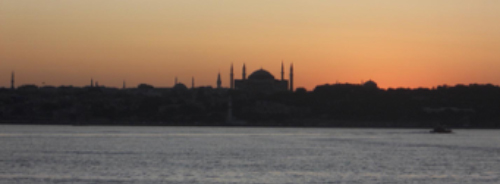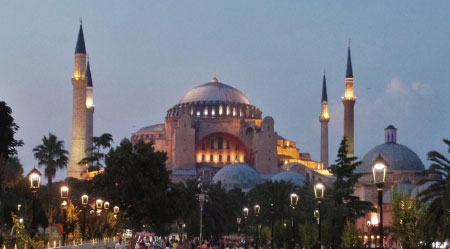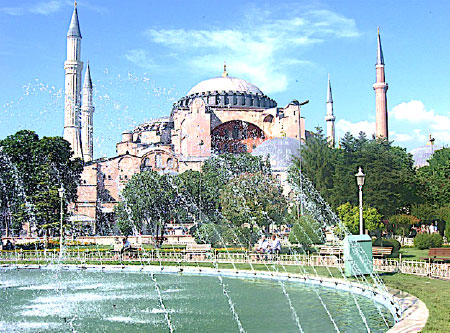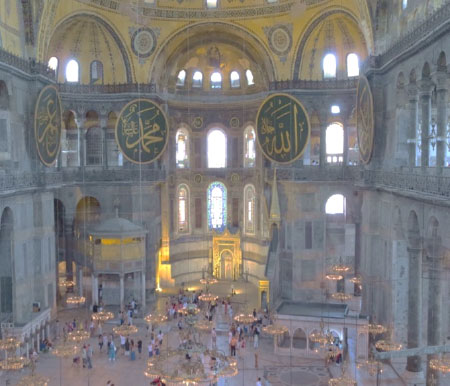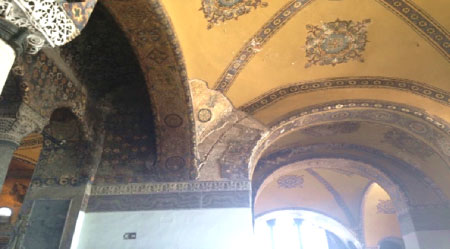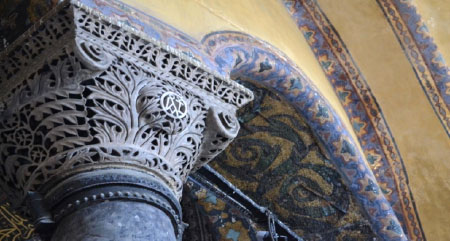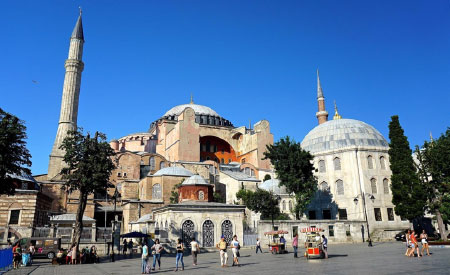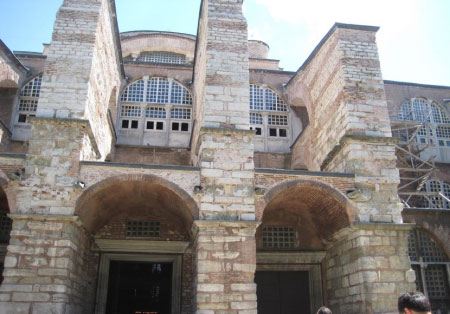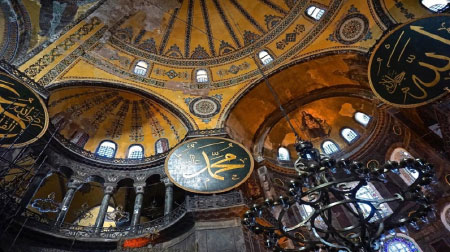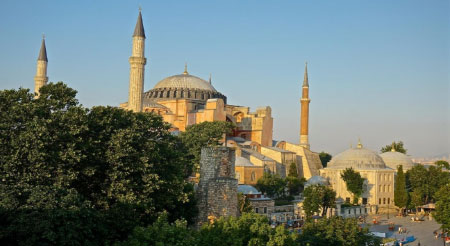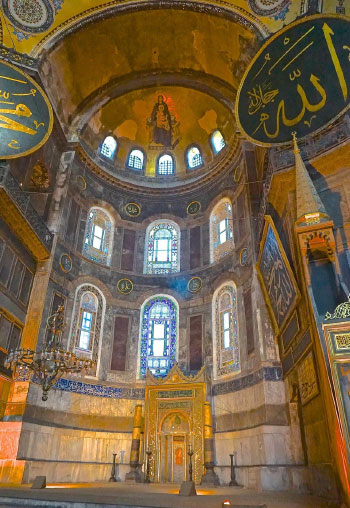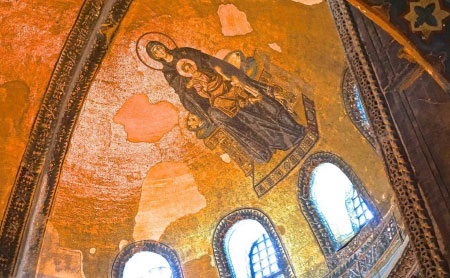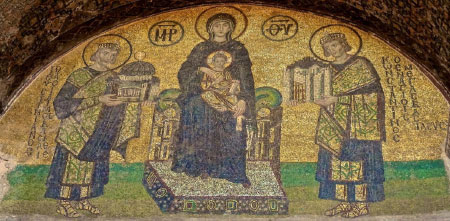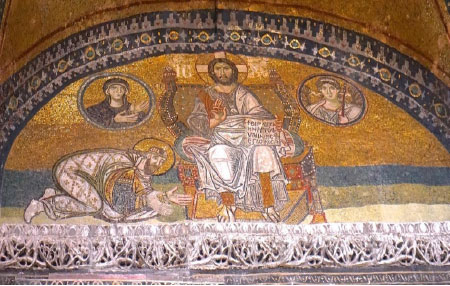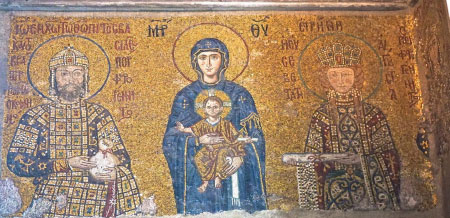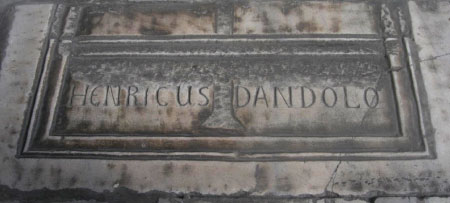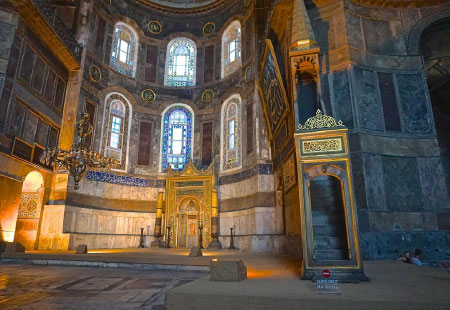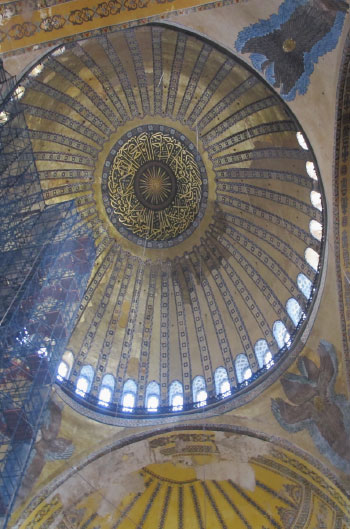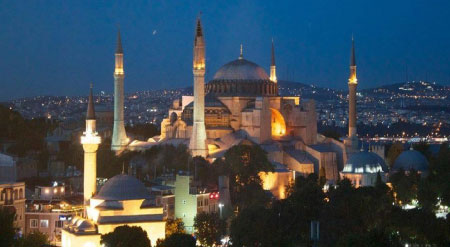Broadcasting Power: Teaching Historical Transformation through Hagia Sophia
Matthew T. Herbst
|
|||
| Figure 1: Image of Hagia Sophia, looking west from the Bosphorus. Photo Credit: Matthew Herbst, University of California San Diego. 2015. | |||
Introduction to Hagia Sophia: Contested and Transforming Meaning
A few years ago, I gave a public lecture at a Christian college on the topic of Constantinople's role as an imperial capital for both the Byzantine and Ottoman Empires. A teacher at the institution raised his hand and asked, with a notable level of swagger: "What would it take to make Hagia Sophia a church again?" "World War III," was my response. By this, I meant that only a cataclysm of such extreme magnitude could overturn the ideologies that have dominated Turkey for centuries, whether the premier place of Islam in the region since the Ottoman conquest, or the secular legacy of Mustafa Kemal in the twentieth century, or the contemporary religious nationalism of Recep Tayyip Erdoğan and his Justice and Development Party (Adalet ve Kalkınma Partisi, or AKP), which has dominated the first decades twenty-first century. In none of these perspectives, would a proposal to restore Hagia Sophia as a Christian place of worship, which it has not been since 1453, receive even the slightest merit. For, from the building's very inception, it has always served as a marker and, in fact, promoter of the dominant ideology of the day, with Orthodox Christianity reigning supreme for the first millennium, with a brief Catholic interlude in the thirteenth century, then Islam for the following centuries, and then secularism in the twentieth century. It is that last foundation that has been undermined in the twenty-first century and suggests that another transition might well be forthcoming. It is precisely such transitions that make Hagia Sophia so useful in the World History classroom, through which students can apply core analytical skills of the discipline, including the examination of historical and cultural transformation, the processes of change and continuity, while exploring a variety of perspectives on the matters at hand, examples of which are offered at the close of this analysis.
|
|||
| Figure 2: Hagia Sophia at dusk. Photo Credit: Kristin Hall, George Rogers Clark High School, Winchester, KY. 2015. | |||
Hagia Sophia as Symbol
Istanbul's greatest monument, Hagia Sophia ("Holy Wisdom" in Greek), or Aya Sofya as it is known today, furnishes an ideal site for such analysis.1 The museum of Aya Sofya has long been the most popular historic site in Turkey, with more than 3 million visitors annually, despite a recent downturn.2 Hagia Sophia also routinely appears in world history classes as the symbolic epitome of the Byzantine Empire, even with minarets present in powerpoint presentations used in classes, which immediately reveal something non-Byzantine. Teachers of world history regularly utilize such anomalies in their curriculum, as they move from the Byzantine to the Ottoman Empires and then to the Republic of Turkey. This article highlights and reviews the changing appearance and the monumental message of this masterpiece and considers possible implications for the future.
Hagia Sophia as Premier Christian Church
The first church on the site was consecrated in 360 by Emperor Constantius (r. 337-361), only a few decades after his father, Emperor Constantine I (305-337), had founded the city of Constantinople, which was begun in 324 and dedicated on May 11, 330, and which absorbed the existing Greek city of Byzantium. This first building burned down during riots that engulfed the capital after the imperial couple, Arcadius (r. 395-408) and Eudoxia (d. 404), exiled John Chrysostom, the popular Patriarch of Constantinople, in 404. The second church on the site was built early in the reign of Theodosius II (r. 408-450), son of Arcadius and Eudoxia, and it was this church that was destroyed in the most notorious urban tumult in the city's history, the Nika Riot.3
This riot broke out as a confluence of events in response to the political and economic reforms of Emperor Justinian (r. 527-565).4 The emperor sought to improve the efficiency of the state bureaucracy, suppress corruption, improve tax collection, and eliminate governmental structures that were wasteful or redundant. In this effort, he called for the review and organization of Roman law, which produced the Code of Justinian in 529 (with an official revision in 534), along with an authorized legal commentary, the Digest, and an authoritative textbook, the Institutes, completed shortly thereafter. Justinian's legislation continued after this codification and his new laws, called Novels (Latin Novellae, "new laws"), supplemented the Code. Taken together, the Code, Digest, Institutes, and Novels, are referred to as the Corpus Juris Civilis (CJC), an achievement as monumentally significant as its parallel in stone, Hagia Sophia. This administrative and political program also conveyed an ideological message of renewal, that the emperor, guided by divine favor, was returning the state to its past grandeur.
|
|||
| Figure 4: Hagia Sophia, with its Byzantine dome, Ottoman minarets, and modern fountain. Photo Credit: Matthew Herbst, University of California San Diego. 2015. | |||
Riots were not uncommon in Constantinople, which experienced a marked increase in intensity and violence in the sixth century, culminating in this week-long urban uprising in January 532. The crowd raged beyond the hippodrome, which could hold some 80,000 people or more, and razed much of downtown Constantinople, shouting "Nika" ("Conquer") as they rampaged. The rioters demanded the deposition of several high-ranking officials associated with the emperor's reforms and then began calling for a change on the throne itself, looking to a member of the family of Anastatius (r. 491-518), whose rule had preceded Justinian's family in power. Hoping and anticipating that Justinian's reign was collapsing, many senators rallied to the rival claimant. It was at this dire moment that Empress Theodora (d. 549) strengthened her husband's will to stand firm. This stance was made easier by the fortunate presence of two experienced and loyal commanders, Belisarius from the Persian frontier and Mundo from the Balkans. It was their joint operation that brutally suppressed the uprising, leaving a death toll of some 30,000.
In the aftermath of this upheaval, Justinian executed the imperial claimants and punished disloyal senators with exile and the confiscation of property. Justinian also responded by building, which further manifested his "renewal" ideology. On the rubble of the former church emerged a new and vastly more monumental Hagia Sophia. The emperor entrusted the endeavor to two scientists and mathematicians, Athemius of Tralles and Isidore of Miletos, the latter of whom assumed sole control after Anthemius died early in the construction. Their architectural model was bold in design and innovative in scale: a structure measuring 230 by 246 feet (70 by 75 meters), topped by an enormous central dome spanning more than 100 feet (31 meters) across, resting 180 feet (55 meters) above the ground, and supported by surrounding half-domes. The designers also made astonishing use of colored stone, particularly in conjunction with the effect of sun- and candle-light, which greatly enhanced the impact on viewers.
|
|||
| Figure 5: Nave of Hagia Sophia, facing the apse and mihrab. Note how the mihrab is just off center, placed to align with Mecca, which was not the necessary orientation at the building's construction. To the left of the apse is the nineteenth-century Ottoman loge, the raised and private platform for the Sultan's worship, and the colonnaded structure to the left of that is Mahmud I's library built in the eighteenth century. To the right of the apse is the seventeenth-century minbar, or preacher's seat, which points upward to the nineteenth-century medallion above. The yellow-ish section at the top is Ottoman plaster, contrasted by the splendor of the ninth-century Byzantine mosaic in the apse. Photo Credit: Matthew Herbst, University of California San Diego. 2015. | |||
Hagia Sophia as Political Message
Built in just five years and consecrated on December 27, 537, Hagia Sophia emerged as an assertion of the emperor's supremacy over all rivals. Upon its completion, the emperor was said to have boasted that his work had surpassed the temple of King Solomon in Jerusalem, but this declaration was also aimed at established elites, who were also patrons of churches. Justinian needed his message to be unambiguous, both in policy and in stone, that his power was without challenge. Thus, Hagia Sophia had to outshine the city's grand Church of St. Polyeuktos, which had been built a decade earlier by a member of an eminent and long-established aristocratic family, Anicia Juliana. She was the daughter of the Western Emperor Olybrius (r. 472) and the great-great-grand-daughter of Emperor Theodosius I (r. 379-395). During an urban riot in 512, the people of Constantinople called upon her husband, Aerobindus, to replace Emperor Anastasius, though he remained loyal. On Anastatius' death in 518, her son, Olybrius, was a competitor for the imperial throne, but lost out to the commander of the imperial guard, Justin (r. 518-527), who was Justinian's uncle and imperial predecessor. Though her family had failed to achieve imperial status in Constantinople, she advertised her influence by building the Church of St. Polyeuktos, then the largest in the city. The church's dedicatory poem praised her aristocratic lineage and also linked her construction to Solomon's temple.5 This architectural "billboard" posed a competing challenge to Justinian, who was from peasant stock in the Balkans and could boast no such lineage. Thus, Hagia Sophia was the emperor's dynamic response and it overshadowed her boast. This was a monument to Justinian and his partner in power, Theodora, who are still present through their monograms inscribed into the capitals of the building's columns.
|
|||
| Figure 6a: Hagia Sophia, column capital with imperial initials at center. Behind, contrast the Byzantine mosaic to the right, with the Ottoman plaster above. Photo Credit: Sue Protheroe. Solon Middle School. Solon, IA. 2015. | |||
|
|||
| Figure 6b: Hagia Sophia. Contrast the original Byzantine mosaic ceiling with the Ottoman plaster covering it. Photo Credit: Megan Anne Rice. Pelham, NY. 2015. | |||
Emotional Impact on the Viewer
Furthermore, Hagia Sophia was a statement of the supremacy of Christianity and of the empire's technological and economic preeminence. This architectural accomplishment was so profound that it would have no meaningful imitation in the empire or anywhere in the Christian West for a millennium. In his Buildings, written around 550, Byzantine historian Prokopios stated that if anyone would have known that this church was to be so impressive, he would have called for the destruction of the previous one, as if the riot had fulfilled some divine plan for this masterwork to emerge. For the observer, the sight of the building was overwhelming "…for each detail attracts the eye and draws it on irresistibly to itself. So the vision constantly shifts suddenly, for the beholder is utterly unable to select which particular detail he should admire more than all the others." Particularly mesmerizing was the effect of light in the interior because "[t]he whole ceiling is overlaid with pure gold, which adds glory to the beauty, yet the light reflected from the stones prevails, shining out in rivalry with the gold." Finally, the work as a whole clearly reflected the presence of the divine hand: "And whenever anyone enters this church to pray, he understands at once that it is not by any human power or skill, but by the influence of God, that this work has been so finely tuned. And so his mind is lifted up toward God and exalted, feeling that He cannot be far away, but must especially love to dell in this place which He has chosen….Of this spectacle no one has ever had a surfeit."6 Then just as now, those fortunate enough to behold the building are commonly struck by the wonder of it and by a desire to talk about the experience.
|
|||
| Figure 7: Hagia Sophia. Looking at the apse. Photo Credit: Matthew Herbst, University of California San Diego. 2015. | |||
Such was the context when envoys of Prince Vladimir of Kiev visited Constantinople in the later tenth century. The message of Hagia Sophia was on full display and the building played a role in Byzantine diplomacy, leaving the representatives awe struck at the visual and aesthetic experience. They confessed that 'we knew not whether we were in heaven or on earth. For on earth there is no such splendor or such beauty and we are at a loss how to describe it. We only know that God dwells there among men.'7 And so, Kiev gravitated to the Orthodox Christianity of Hagia Sophia and Byzantium, as would Russia thereafter.
|
|||
| Figure 8: Hagia Sophia, with Ottoman türbe (mausoleum) of Sultan Murad III (d. 1595) at right. Photo Credit: Arlis Groves, Toby Johnson Middle School. Elk Grove, CA. 2015. | |||
Environmental Challenge: Hagia Sophia and Earthquakes
Justinian's monument to divine and imperial power may have been brilliantly effective, but it faced one particularly troubling problem. Constantinople rests along the 560-mile (1200km) North Anatolian Fault, which shook the city dozens of times during the Byzantine Empire.8 The trouble began soon after construction, when quakes caused the eastern portion of the original dome and its supporting structure to give way on May 7, 558. Justinian entrusted the reconstruction to Isidore the Younger, nephew of the deceased Isidore of Miletus, who fortified the dome by raising it several meters and adding buttresses to the exterior of the building. Hagia Sophia was rededicated in 563. These were the first modifications to the appearance of building, which could continue for the duration of the building's life.
|
|||
| Figure 9: Buttresses of Hagia Sophia. Photo Credit: Matthew Herbst, University of California San Diego. 2015. | |||
Hagia Sophia withstood tremors over the subsequent centuries and during the Macedonian Dynasty (867 – 1056), the high point of Byzantine power, major quakes threatened the building. Emperor Basil I (r. 867-886), founder of the dynasty, added buttresses in the later ninth century. A century later, in 989, the dome again partially collapsed. Emperor Basil II (r. 976-1025) hired an Armenian architect named Trdat, designer of the cathedral at Ani, to restore the dome and the church was rededicated on May 13, 996.9 Hagia Sophia withstood more shocks in the following centuries and in the early fourteenth century, Emperor Andronikos II Palaiologos (r. 1282-1328) further strengthened the structure by adding buttresses on the north and south sides of the building, which add to the distinctive appearance of the building today, though this also made it further removed from the exterior appearance of the structure built by Justinian.
|
|||
| Figure 10: Nineteenth-century Ottoman medallions and a ninth-century Byzantine mosaic in the apse, bordered above by Ottoman plaster. Photo Credit: Arlis Groves, Toby Johnson Middle School. Elk Grove, CA. 2015. | |||
The structural addition by Andronikos II provided critical support when another earthquake struck not long thereafter in the 1340s, which again damaged the building, when the eastern arch collapsed, bringing down one third of the dome on May 19, 1346. By this time, however, the Byzantine Empire was long removed from the era of wealth and power of Justinian or the Macedonian dynasty, struggling politically and financially. Repairs took nearly a decade, marking the last major maintenance work done until Sultan Mehmed II conquered the city in 1453.
Sultan Mehmed added the first minaret and additional buttresses as did Mimar Sinan, the most famous Ottoman architect, in the later sixteenth century. Thus, the building as we see it today reflects a long process of transformation and has a significantly different appearance from the one Justinian originally commissioned. Hagia Sophia is an amalgam of additional parts that were themselves responses to environmental challenges needed to keep the building "alive." The wonder that it has remained standing has been the subject of much study and efforts continue to reinforce the monument for the great quake predicted to hit the region in the near future.10
|
|||
| Figure 11: Hagia Sophia, featuring buttresses jutting outward. Photo Credit: Arlis Groves, Toby Johnson Middle School. Elk Grove, CA. 2015. | |||
These Walls Talk: The Art of Hagia Sophia
Because of the building's function as a statement of power, rulers sought to weave themselves into the monument through addition and renovation. This is most obviously seen in the figural mosaics, the earliest of which dates from the ninth century, that is, from the post-iconoclastic period. The first of these mosaics is that of the Virgin Mary and infant Jesus, prominently located in the apse. The mosaic was inaugurated on Easter Sunday, March 29, 867, during the reign of co-emperors Michael III (r. 843-867) and Basil I the Macedonian (r. 867-886). Photios, Patriarch of Constantinople, gave a sermon to commemorate the installation of the great icon, located directly overhead. This mosaic proclaimed the triumph of icon veneration after a century of Iconoclastic threat (726 – 842). Photios called the congregation to behold:
A virgin mother carrying in her pure arms, for the common salvation of our kind, the common Creator reclining as an infant – that great and ineffable mystery . . . A virgin mother with both a virgin's and a mother's gaze, dividing in indivisible form her temperament between both capacities yet belittling neither by its incompleteness. With such exactitude has the art of painting, which is a reflection of inspiration from above, set up a lifelike imitation. For she fondly turns her eyes upon her begotten child in the affection of her heart . . . You might think her not incapable of speaking . . . To such an extent have the lips been made flesh by the colours ...11
The mosaic represents the triumph of Orthodoxy over the challenge Iconoclasm, though would centuries later be covered over with plaster because of the Iconoclasm of Islam in the Ottoman period, and then uncovered again in the twentieth century, when the building became secular a museum.
|
|||
| Figure 12a: Looking up at the apse of Hagia Sophia. Photo Credit: Arlis Groves, Toby Johnson Middle School. Elk Grove, CA. 2015. | |||
|
|||
| Figure 12b: Ninth-century apse mosaic of the Virgin and Child. Photo Credit: Arlis Groves, Toby Johnson Middle School. Elk Grove, CA. 2015. | |||
The building's mosaics also highlighted the sanctity of the capital by honoring saints with Constantinopolitan connections, including Patriarch John Chrysostom (d. 407), the greatest preacher in the empire's history, and the renowned ascetic and iconophile bishop, Ignatius the Younger (d. 877). These accentuated the holiness of the patriarchal church and of those entrusted to oversee the empire's ecclesiastical administration.
The imperial presence was also represented in mosaic fashion. A tenth-century mosaic prominently portrays Emperors Constantine and Justinian, the two figures who fundamentally shaped the Byzantine world view: Constantine founded the "Queen of Cities" in the fourth century and Justinian was responsible for the very monument in which the viewer was standing.
|
|||
| Figure 13: Tenth-century mosaic of Justinian (left) and Constantine (right) before the Virgin and Jesus, presenting Hagia Sophia and Constantinople, respectively. Photo Credit: Arlis Groves, Toby Johnson Middle School. Elk Grove, CA. 2015. | |||
In the same period, above the massive imperial doorway way separating the narthex and the sanctuary, at the threshold where patriarch and emperor would meet, a mosaic prominently displays the piety of an emperor, shown kneeling before the enthroned Jesus. One interpretation is that it was sponsored by Emperor Constantine VII (r. 913 – 959) to portray his father, Emperor Leo VI (r. 886-912), as piously repentant. Leo had violated canon law by marrying a fourth time, his first three wives having died without heir. His fourth wife gave birth to a son, the future Constantine VII. This so-called "Tetragamy ('Four Marriage') Affair" erupted into a major ecclesiastical and political controversy which nearly cost the emperor his throne. Leo succeeded in holding power and obtaining his heir, who may have commissioned this mosaic as a response.12
|
|||
| Figure 14: Penitent emperor, possibly Leo VI. Photo Credit: Arlis Groves, Toby Johnson Middle School. Elk Grove, CA. 2015. | |||
More easily identifiable imperial portraits from the Macedonian dynasty are found on the building's second floor: Emperor Alexander (r. 912-913) and Empress Zoe (r. 1028-1050) along with her husband, Emperor Constantine IX Monomachos (r. 1042-1055). Zoe's mosaic reveals a transparent revision, where the artists painstakingly altered the mosaic so that it represented Zoe's third husband, Constantine. Such was the challenge of alterations before the convenience of the "delete button" in the digital age.
|
|||
| Figure 15: Emperor Constantine IX Monomachos and Empress Zoe. Notice the altered mosaic above the emperor's head, marking a necessary update in the mosaic after Zoe's remarriage (her third). Photo Credit: Arlis Groves, Toby Johnson Middle School. Elk Grove, CA. 2015. | |||
To the right of Zoe's mosaic from the late Macedonian Dynasty is an imperial portrait from the Komnenos Dynasty (1081-1185), showing John II Komnenos (r. 1118-1141) and his Hungarian wife, Irene (d. 1134) with their son and heir, Alexios (d. 1142).
|
|||
| Figure 16: Emperor John II Komnenos and Empress Irene, with their son, Alexios, at right. Photo Credit: Arlis Groves, Toby Johnson Middle School. Elk Grove, CA. 2015. | |||
Constantinople and the Crusades: Hagia Sophia as a Catholic Church
In 1204, Western Christian Crusaders stormed and sacked Constantinople in the Fourth Crusade.13 Previously, each of the first three Crusades (1096 – 1192) had resulted in increasing tensions between the Byzantine Empire and Western military forces, which passed through en route to the Holy Land. This tension culminated in the assault by the Latin armies of the Fourth Crusade against the Orthodox Christian empire, resulting in Catholic, rather than Orthodox, supremacy in Constantinople. The roots of discord between the two branches of Christianity was centuries old, but they had only officially separated in 1054 through the mutual condemnations between Papacy and Patriarchate. This theological and ecclesiastical rift widened into a deeply entrenched cultural divide by the inimical experience of the Crusades. With a Catholic ruler and Catholic patriarch now imposed on the city, the Latin authorities appropriated Hagia Sophia for the Catholic liturgy. The building suffered during the assault on the city and would continue to bleed for decades. The Crusaders plundered relics and precious objects, including the celebrated crown of thorns which eventually passed to King Louis IX, inspiring the construction of St. Chapelle in Paris, but such scars are not visible in the current building. The only obvious remnant of this occupation is a tombstone of the Venetian Doge, Enrico Dandolo (d. 1205), who had led the assault against Constantinople and, as a mark of honor, was interred here. The tombstone, easily missed today, is located at ground level on the building's second floor, directly across from a post-Crusade Byzantine mosaic of Jesus, the Virgin Mary, and John the Baptist. The marker does not, however, date from the medieval period. After the Ottoman conquest, Dandolo's body was unceremoniously removed and discarded from the church, making the original location of his body uncertain. The marker was only set in place by the Fossati brothers, the Italian-Swiss architects hired by Sultan Abdülmecid to restore and strengthen Hagia Sophia in 1847-1849, which will be discussed below.
|
|||
| Figure 17: Nineteenth-century memorial to Crusader and Venetian Doge Enrico Dandolo (d. 1205). Photo Credit: Matthew Herbst, University of California San Diego. 2015. | |||
Recovery and Restoration: Hagia Sophia as Orthodox Church, again.
Emperor Michael VIII Palaiologos (r. 1259-1282), founder of the empire's final dynasty, the Palaiologan (1259-1453), recaptured Constantinople in 1261 from his base of operation at Nicaea in Anatolia. He then struggled for decades to stem the imminent Western Christian threat of a second conquest.14 Michael also set about restoring the city after decades of Crusader neglect (1204-1261), presenting himself as a new Constantine, a new founder of the city. Hagia Sophia was rededicated as an Orthodox Christian cathedral and Michael was re-crowned in the cathedral, site of the traditional coronation ceremony of Byzantine emperors, even though he had already received the crown at Nicaea. Michael also likely installed the magnificent mosaic of the deësis ("supplication") in the second-floor gallery to entwine himself into the building's history. The mosaic presents Christ between the Virgin and John the Baptist who intercede on the world's behalf. It was Michael's son, Andronikos II (r. 1282-1328), who, as mentioned previously, had added the final buttresses of the Byzantine period in the early fourteenth century.
|
|||
| Figure 18: Deësis. Jesus at center, with Virgin Mary and John the Baptist. Photo Credit: Arlis Groves, Toby Johnson Middle School. Elk Grove, CA. 2015. | |||
Ottoman Conquest: Hagia Sophia as Mosque
On May 29, 1453, Constantinople passed from Byzantine to Ottoman hands and was transformed into the new Ottoman imperial capital. Fatih ("Conqueror") Sultan Mehmed II (r.1451-1481) entered the city through the battered walls and rode directly to Hagia Sophia. The sultan entered the building, after sprinkling dirt upon his turban, a gesture of humility and reverence.15 Mehmed saw in Hagia Sophia the inheritance of imperial power and as such, it was a monument that needed to be co-opted, even the building's name was left intact. The city fell on a Tuesday and the first call to prayer was made on Friday of the same week. Purged of some (though hardly all) Christian symbols, the building would continue to signify the region's dominant religion, which had just changed that very week, with the sound of church bells replaced by the muezzin.16 The city's patriarch was evicted, forced to relocate elsewhere in the city. After several moves in the fifteenth and sixteenth centuries, the patriarchate settled at its present location on the Golden Horn at the Church of St. George in the city's Fener neighborhood.
|
|||
| Figure 19: Mihrab, the prayer niche, bordered by massive candles taken by Sultan Suleyman the Magnificent after his conquest of Buda in 1526; and the seventeenth-century minbar, or preacher's chair, at right. Photo Credit: Arlis Groves, Toby Johnson Middle School. Elk Grove, CA. 2015. | |||
Mehmed invested in the restoration and upkeep of Hagia Sophia, or Aya Sofya as it became known. He also made necessary changes to retrofit it for Muslim worship, adding the prayer niche (mihrab) which denotes the direction of Mecca. The niche, however, is slightly off center, since Mehmed could not turn the entire building to make it align properly with the Muslim architectural protocol of facing Mecca. The sultan also added a pulpit (minbar; though the present one dates from the seventeenth century), the first minaret, and additional buttresses. He did not, however, express any zeal to remove mosaics, which largely remained evident through the sixteenth century. It was in the reign of Sultan Ahmed I (r. 1590-1617), who ordered repairs to Aya Sofya, that many mosaics were covered with plaster, including the image of Christ in the dome, though the Virgin and Child in the apse were left intact. During Ahmed's reign "the state religion…was taking a puritanical, even dogmatic turn…" and included "laws restricting the apparel of Christians and Jews were issued, and the drinking of alcohol banned, albeit briefly. . . 17 Another century passed before Mahmud I (r. 1730-54) made further repairs and added a library on the south side of the nave and also a children's school and community kitchen outside.
The Prophet in Hagia Sophia: Creating a Muslim History
Hagia Sophia was so important that a Muslim backstory emerged. It should be noted that a millennium before, Christians had likewise created a backstory for Constantinople in order to demonstrate apostolic connection for a city that is not mentioned in the Bible and that did not even exist before the fourth century. They did so by claiming that the apostle Andrew passed through Byzantium, Constantinople's predecessor, and through this, the imperial capital gained indisputable apostolic credentials. In the Muslim case, the city had to be connected to the life of the Prophet Muhammad and it had to reckon with the city's non-Muslim past, how the divine had allowed the building to be in the care of Christians until such time when Muslims were ready to assert their rightful control. During his siege of the city, Mehmed II had "discovered" the remains of Ayyub al-Ansari, the standard bearer of the Prophet, who had participated in and died during the first Arab assault on the city in the seventh century. This location, just outside the Byzantine walls in Istanbul's Eyüp neighborhood, which still takes its name from the 5th Century monastery of the Anargyroi (Saints Cosmas and Damian), but became a sacred Muslim site and pilgrimage destination, and it remains as such today. This was one way to connect the life of Muhammad to the city.
In this purified state of affairs after the Ottoman conquest, it was said that prayers made in Hagia Sophia were more readily heard by the divine. Moreover, it was even claimed that the dome's first collapse had only been restored when saliva of the prophet Muhammad was mixed with the mortar. Such sanctity was imbedded in the very mortar of the building, which could account for the site's ability to withstand earthquakes and other assaults. In fact, a story of another bodily fluid reflects this very idea. During the repairs of Sultan Ahmed I's reign, a craftsman working on the dome, chose, out of convenience, to relieve himself into a bucket of lime instead of making his way down to ground level to attend to nature. When he resumed his work, attempting to use this offensive mixture, the building itself, outraged at the affront, hurled the worker down to his death. Informed of this incident, the sultan begged the divine for forgiveness and issued a law strictly enforcing an appropriate bathroom protocol.18
The sanctity of the building is further reflected by the presence of Ottoman türbe, or mausolea, for the remains of sultans and their families, which were built on the building's south side. These are routinely ignored by tourists, despite their remarkable architectural and artistic designs as well as historical importance. Five sultans of the later sixteenth and early seventeenth century rest here, along with their wives and children. Mimar Sinan, the most celebrated Ottoman architect, who constructed three of Hagia Sophia's four minarets, and made additional renovations to the building, built the first türbe for Selim II (r. 1566-1574).
|
|||
| Figure 20: Ottoman pendants. Photo Credit: Kristin Hall, George Rogers Clark High School. Winchester, KY. 2015. | |||
Hagia Sophia in the Long Nineteenth Century: Balancing Islam and the West
In the nineteenth century, Ottoman sultans began to assert their role as caliph in the Muslim world, for which purpose, a restoration and renovation of Hagia Sophia was fitting. Sultan Abdülmecid (r. 1839-1861) hired the Italian-Swiss architects Gaspare and Giuseppe Fossati, who had been working in Istanbul and surrounding areas on a wide range of architectural projects, to strengthen and restore the building after a long period of neglect. Their efforts lasted from 1847 to 1849 and included the most noticeable additions to the interior: the colossal round wooden medallions which are suspended from the walls in the nave and bear the names of Allah, the prophet, and the first four Caliphs. The Arabic calligraphy on the pendants was the work of Mustafa Izzet Efendi, who is also responsible for the Quranic inscription in the dome, inspired by Sura 24:35: "In the name of God the Merciful and Pitiful; God is the light of Heaven and Earth. His light is himself, not that which shines through the glass or gleams in the morning star or glows in the firebrand." Whatever value this project may have had for bolstering the sultan's position in the Muslim world, the restoration was also a nod to the interests of western preservationists and the Fossati brothers documented mosaics which they had re-discovered and then re-covered with plaster.
|
|||
| Figure 21: Dome. Quranic calligraphy inscription at center. Scaffolding for renovation work at left. Also evident are the angelic seraphim. Credit: Priscilla Zenn. Dearborn, MI. 2015. | |||
Despite this care and renovation, at least one observer was less smitten by the historic importance and grandeur of the building. In his Innocents Abroad, the iconoclastic American author Mark Twain declared:
I do not think much of the Mosque of St. Sophia. I suppose I lack appreciation. We will let it go at that. It is the rustiest old barn in heathendom. I believe all the interest that attaches to it comes from the fact that it was built for a Christian church and then turned into a mosque, without much alteration, by the Mohammedan conquerors of the land. They made me take off my boots and walk into the place in my stocking-feet. I caught cold. . . St. Sophia is a colossal church, thirteen or fourteen hundred years old, and unsightly enough to be very, very much older. Its immense dome is said to be more wonderful than St. Peter's, but its dirt is much more wonderful than its dome, though they never mention it…The inside of the dome is figured all over with a monstrous inscription in Turkish characters, wrought in gold mosaic, that looks as glaring as a circus bill…The people who go into ecstasies over St. Sophia must surely get them out of the guide-book (where every church is spoken of as being "considered by good judges to be the most marvelous structure, in many respects, that the world has ever seen.")"19 Twain's keen eye often saw through the veneer of cultural norms to expose inequity and absurdity. Yet, that same eye suffered from notable blind spots, as when looking at Native Americans in the United States or Hagia Sophia in Constantinople.
From Constantinople to Istanbul: Hagia Sophia as Monument of Secularism
The Ottoman Empire crumbled after the First World War and the nation of Turkey emerged out of its wreckage, under the leadership of Mustafa Kemal "Atatürk" (d. 1938), who rejected the imperial and pan-Islamic claims of the Ottoman Empire and sought to build a republic on Turkish nationalism, secularist principles, and Westernized institutions and science. The Turkish past was now to be emphasized in place of the Ottoman and the Muslim, and the offices of sultan and caliph were officially terminated, and Istanbul became the official name for the former imperial capital. To manifest this new approach, Hagia Sophia could no longer remain a mosque and had to be transformed to reflect a new ideological message. And so, by 1935 Hagia Sophia began its next phase as a museum, serving the purpose of historical study and presentation, rather than for religious worship. In fact, public prayer became explicitly forbidden. This dramatic change of policy thwarted Muslim claims on the building as well as western voices which had called for its return to Christianity after the defeat of the Ottoman Empire.20 Over the following decades, Byzantine mosaics, some of which had been identified by the Fossati brothers, were carefully uncovered for public view and by 1985, the building was recognized as a UNESCO world heritage site.
|
|||
| Figure 22: Pendants and angels. Credit: Arlis Groves, Toby Johnson Middle School. Elk Grove, CA. 2015. | |||
The Future of Hagia Sophia and Turkey: Another Religious Turn?
Turkey's secular foundation, which was established by Mustafa Kemal and was evident through Hagia Sophia museum, remained firmly in place until the rise of Recep Tayyip Erdoğan and his Justice and Development Party (AKP) in 2003. With the AKP in power, the first decades of the twenty-first century have witnessed a dramatic undermining of the legacy of Mustafa Kemal; and Hagia Sophia continues to retain a central place in this unfolding battle. The current government nods in support of the increasing momentum for the building's restoration as a mosque.21 Such a proposed change would mean the loss of revenue from the nation's top tourist attraction, but that fear is already being contested with an alternate claim that revenue lost would be offset by the donations of Muslims patronizing this most historic place of worship. It is not at all surprising, then, to find that Turkey's Ministry of Tourism officially reported that Hagia Sophia dropped from the most visited tourist site in 2016 to the third most in 2017, whereas Ottoman Topkapı palace was reported as second, which is somewhat surprising since that is located right next to Hagia Sophia. Why choose the former over the latter? The Muslim shrine of the Sufi saint Jalal ad-Din Rumi in Konya (in Anatolia) was reported as the nation's number one tourist destination. Such facts or perhaps "facts" may be of use in justifying a change, which would ensure that Hagia Sophia again reflects the dominant ideology of the day, as it has done since its foundation.
|
|||
| Figure 23: Hagia Sophia illuminated. Photo Credit: Matthew Herbst, University of California San Diego. 2015. | |||
Teaching World History
This article did not seek to offer a detailed history of Hagia Sophia, the challenge of that task is evident by the fact that it has yet to be done. Rather, the goal of the article was limited to highlighting a few avenues for using Hagia Sophia for exploration and analysis in the teaching of world history. Among the possibilities: have students examine points of continuity as the building transitioned from Byzantine to Ottoman to Turkish, from Christian to Muslim to secular, as well as contrast key differences at each phase. Investigate the many cultural and political forces at play in various eras, such as Christianity and Islam, Byzantine and Ottoman, imperialism, nationalism, and Westernization. Analyze comparatively across regions, contrasting the physical structure and the general significance of Hagia Sophia with that of western medieval cathedrals or with Hindu and Buddhist temples in Asia. Draw on the history of science and engineering to study the problem of earthquakes, which provides much interdisciplinary possibility, with modern scientific study continuing to investigate the building's success as well as working to ensure its stability for the future. This is a very brief list, but thanks to the creativity of teachers, there is simply no end to the pedagogical possibility of Hagia Sophia.
Matthew T. Herbst is Director of the Making of the Modern World, a general education World History program at the University of California San Diego. He can be contacted at matthewherbst@ucsd.edu. See also https://ucsdherbst.org.
1 There are many studies that provide expert insight on Hagia Sophia at various stages of its history. Yet, there is no study that provides a comprehensive historical survey of the structure. Among the useful places to begin an inquiry include Robert Mark and Ahmet Çakmak, eds., Hagia Sophia from the Age of Justinian to the Present (Cambridge: Cambridge University Press, 1992), and Robert S. Nelson, Hagia Sophia, 1850-1950. Holy Wisdom Modern Monument (Chicago: University of Chicago Press, 2004); a concise introduction is found in Judith Herrin. Byzantium: The Surprising Life of a Medieval Empire (Princeton: Princeton University Press, 2009), 50-60; for a contemporary reflection, see Anna Bigelow, "Hagia Sophia's Tears and Smiles: The Ambivalent Life of a Global Monument," in Istanbul: Living with Difference in a Global City, eds. Nora Fisher-Onar, Susan Pearce, and Fuat Keyman (Rutgers: Rutgers UP, 2018), 112-127.
2 "Hagia Sophia Still Istanbul's Top Tourist Attraction," Hürriyet Daily News, January 22, 2016, http://www.hurriyetdailynews.com/hagia-sophia-still-istanbuls-top-tourist-attraction-94210 Accessed July 11, 2019; "Museum, Ancient Site Visitors Rose 17% Last Year in Turkey," Hürriyet Daily News, January 20, 2018. Available at http://www.hurriyetdailynews.com/museum-ancient-site-visitors-rose-17-pct-last-year-in-turkey-126006 Accessed July 11, 2019.
3 For an historical overview of the Byzantine Empire, see Warren Treadgold, A History of the Byzantine State and Society (Stanford: Stanford University Press, 1997).
4 On the reign of Justinian: J.A.S. Evans, The Age of Justinian: The Circumstances of Imperial Power (New York: Routledge, 1996); Michael Maas, ed. The Cambridge Companion to the Age of Justinian (New York: Cambridge University Press, 2005); John Moorhead, Justinian (New York: Longman, 1994).
5 See R.M. Harrison, A Temple for Byzantium: The Discovery and Excavation of Anicia Juliana's Palace Church in Istanbul (London: Harvey Miller, 1989).
6 Procopius, On Buildings, trans. H.B. Dewing and Glanville Downey, Loeb Classical Library no. 343 (Cambridge: Harvard University Press, 1940), Bk 1:11, 21-23, 27.
7 Thomas Riha, ed., Readings in Russian History, Volume 1 (Chicago: Chicago University Press, 1969), 9.
8 Glanville Downey, "Earthquakes at Constantinople and Vicinity, AD 342-1454," Speculum, Vol. 30, no. 4 (October 1955), 596-600.
9 Trdat's role has been questioned. See, for example, Anthony Kaldellis, Streams of Gold, Rivers of Blood: The Rise and Fall of Byzantium, 955 to the First Crusade (New York: Oxford University Press, 2017), 102.
10 See, for example, Şengül Aydingün and Mark Rose, "Saving a Fabled Sanctuary," Archaeology, Vol. 6, no. 6 (November/December 2003), 20-28; and the 2015 Nova documentary "Hagia Sophia: Istanbul's Ancient Mystery." See http://www.pbs.org/wgbh/nova/ancient/building-wonders.html#hagia-sophia Accessed July 11, 2019.
11 Liz James, "Senses and Sensibility in Byzantium," Art History Vol. 27, no. 4 (2004), 31.
12 Nicolas Oikonomides, "Leo VI and the Narthex Mosaic of Saint Sophia," Dumbarton Oaks Papers, Vol. 30 (1976), 151-72.
13 See Donald Queller and Thomas Madden, The Fourth Crusade: The Conquest of Constantinople (Philadelphia: University of Pennsylvania Press, 1997); Jonathan Phillips, The Fourth Crusade and the Sack of Constantinople (New York: Penguin, 2004).
14 Alice-Mary Talbot, "The Restoration of Constantinople under Michael VIII," Dumbarton Oaks Papers. Vol. 47 (1993), 243-261.
15 On the reign of Sultan Mehmed II, see Franz Babinger, Mehmed the Conqueror and His Time, trans. Ralph Manheim (Princeton: Princeton University Press, 1978). On Constantinople's transformation as a Muslim city, see Halil Inalcik, "Istanbul: An Islamic City," Journal of Islamic Studies Vol. 1, no.1 (1990), 1-23.
16 Alex Rodriguez Suarez, "The Fate of Bells under Ottoman Rule: Between Destruction and Negotiation," in Cross-Cultural Interaction Between Byzantium and the West, 1204–1669: Whose Mediterranean Is It Anyway? ed. Angeliki Lymberopoulou (London: Routledge, 2018), 303-317.
17 Caroline Finkel, Osman's Dream: The History of the Ottoman Empire (New York: Basic Books, 2005), 191-95.
18 Gülru Necipoğlu, "The Life of an Imperial Monument: Hagia Sophia After Byzantium," Hagia Sophia from the Age of Justinian to the Present, eds. Robert Mark and Ahmet Çakmak (Cambridge: Cambridge University Press, 1992), 216.
19 Mark Twain, Innocents Abroad (1869), Ch. 33, cite at http://twain.lib.virginia.edu/innocent/text/inn33.html. Accessed July 11, 2019.
20 Philip Mansel, Constantinople. City of the World's Desire, 1453-1924 (London: John Murray, 1995), 384-85.
21 Stephen Starr, "Istanbul's Hagia Sophia is at the Centre of a Battle for Turkey's soul," The Irish Times, January 2, 2018. Available at https://www.irishtimes.com/news/world/europe/istanbul-s-hagia-sophia-is-at-the-centre-of-a-battle-for-turkey-s-soul-1.3342259. Accessed July 11, 2019; Umar Farooq, "Voices Grow Louder in Turkey to Convert Hagia Sophia from a Museum Back to a Mosque," Los Angeles Times, June 24, 2017. Available at http://www.latimes.com/world/middleeast/la-fg-turkey-hagia-sophia-20170615-story.html. Accessed July 11, 2019; "UNESCO's Tricky Balancing Act Between Religious and Secular Forces," The Economist, June 26, 2017. Available at https://www.economist.com/blogs/erasmus/2017/06/whose-heritage Accessed July 11, 2019; see also note 2 above.
